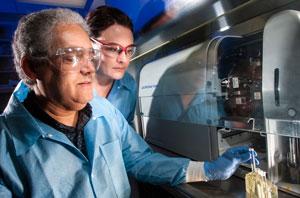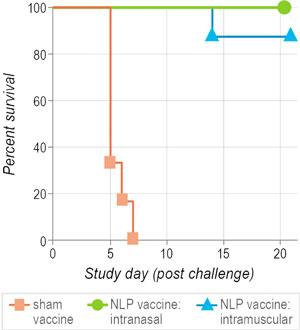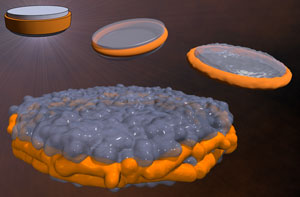Nanoparticle Vaccine Platform Protects Warfighters and First Responders from Dangerous Pathogens
Biotechnology experts are fine-tuning nanolipoprotein technology to harness the body’s immune response against biological threats.
Added Protection Against Attacks
Warfighters face a range of threats, including exposure to infectious diseases and biological warfare agents. Although it can be helpful to provide treatment after exposure, the opportunity to provide vaccines to military personnel prior to deployment would enable a more effective, preventative approach. Unfortunately, vaccines do not exist for many biothreat pathogens, and some existing vaccines cannot fully meet the needs of warfighters. For example, the current anthrax vaccine requires repeated injections over several months to elicit a protective immune response, plus an annual booster to maintain effectiveness. As a result, these types of vaccines have limited utility in protecting warfighters during a biological attack. In addition, most existing vaccines require cold storage and have reduced lifetimes when kept outside the cold-storage chain. This limitation makes it challenging to ship them to military clinics in hot climates for inoculating warfighters in the field. With biothreats on the rise, new vaccine solutions are needed.
Activating the Immune System
A novel nanoparticle platform developed at Livermore offers a potentially transformative approach to preventing infectious diseases. It overcomes the drawbacks of existing vaccine approaches and can be tailored to activate the immune system against multiple pathogens. Nanolipoprotein particles (NLPs) are naturally occurring molecules that serve as structural mimics of cell membranes. NLPs can self-assemble in a relatively simple manner, and much like a set of interlocking building blocks, they can provide a structure or platform for connecting other molecules. Using the body’s innate immune response, the size and stability of the NLP platform makes it possible to develop customized vaccines to target a range of pathogens. Rather than serving as a single-pathogen solution, the NLP platform can work more broadly, providing the foundation to fabricate potent vaccines targeted at biothreats. Since the particles are naturally present in the human body, vaccines produced using the NLP platform are less likely to result in toxicity and will avoid issues associated with current vaccines that involve injecting a live attenuated organism.
Biodefense Mission Relevance
NLP-based vaccines offer the potential to quickly deliver countermeasures to biological warfare agents by rapidly inducing a protective immune response. For example, if a biothreat agent was intentionally released, an inoculated individual, such as a first responder, would most likely not be incapacitated. In addition, NLPs can be easily transported and safely stored for months at room temperature, making them an ideal solution for use in military settings.
These NLP-based vaccines have the potential to protect warfighters from a broad range of traditional and emerging biothreats, using a vaccine platform that is expected to be safer than injections of weakened live micro-organism or neutralized viruses.
Initial Discoveries
The research team has already taken key steps in their investigation regarding the efficacy of NLP-based vaccines based on. One crucial step involved development of NLP-based vaccines that pair adjuvants (molecules designed to boost vaccine potency) with antigens (molecules capable of inducing an immune response from the host organism) to elicit a robust, focused immune response to a specific pathogen.
Researchers are able to attach a specific number of adjuvants and antigens to a single NLP platform, making it possible to administer both types of molecules in a single controlled “package.” They also tested the fabrication process, showing that they could fabricate a vaccine candidate from a specific gene corresponding to protective antigens. These expressed proteins can be easily conjugated to the NLP platform in minutes.In addition, the team addressed the cold-storage issue. They discovered that the NLP-based vaccine could be dehydrated or freeze-dried to form a stable powder, which can be stored for months at room temperature and easily rehydrated for field inoculation.
Unprecedented Protection using NLP-based Subunit Vaccine
Over the last eight years, the team conducted in vivo tests using rodent models to explore the efficacy of the NLP vaccine delivery platform in a biological system. These tests proved that the platform can be customized to activate a focused immune response. Recent studies by the team demonstrated unprecedented levels of protection in rodents against a lethal aerosol using Francisella tularensis, a highly infectious biothreat organism for which licensed vaccines do not exist. In these studies, 100% survival was observed in rats receiving an NLP-based vaccine, as compared with 0% survival in unvaccinated rats.
These results are the first demonstration of complete protection using subunit antigens in a human-relevant challenge model. Interestingly, the survival rate was influenced by the route of vaccine administration.
Next Steps and Future Applications
The team continues to explore the efficacy of NLP-based vaccines, and will test the vaccine platform against bacterial pathogens in nonhuman primates. They are also optimizing the NLP fabrication process to increase the scale of production.
The NLP platform offers the potential to meet a range of medical needs, such as enhanced drug delivery and therapies aimed at treating pathogens that are not completely understood.







